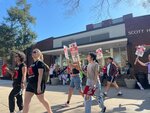A few of our stories and columns are now in front of the paywall. We at The Chief-Leader remain committed to independent reporting on labor and civil service. It's been our mission since 1897. You can have a hand in ensuring that our reporting remains relevant in the decades to come. Consider supporting The Chief, which you can do for as little as $3.20 a month.


The establishment of unions at Starbucks locations, Amazon warehouses and Trader Joe’s grocery stores has drawn national attention in recent months. But quietly, recent unionization efforts among graduate students, medical residents, museum workers and journalists have been far more successful than their more high-profile counterparts, researchers at CUNY’s School of Labor and Urban Studies have found.
Young, college-educated workers have been the driving force behind recent organizing efforts, according to their report, The State of the Unions. The recent wave of labor activity in higher education in particular was attributed to increased support of labor unions among young people — 77 percent of 18-34 year-olds approve of unions — the pandemic’s impact on working conditions, and a wider "labor awakening" among young people.
“It’s what I call the ‘graduate with no future’ phenomenon,” Ruth Milkman, a co-author of the report and a professor of sociology at the School of Labor and Urban Studies, told The Chief during a phone interview. “There is a new generation of college-educated workers who went into their educational trajectories and expected a good job at the end of their studies, and they’re facing a labor market that’s very different from what they were promised.”
A decade ago, there were fewer than 15 student-worker collective bargaining units. But between 2022 and 2023, the number of graduate student bargaining units surged. During this period, 30 bargaining units representing 35,655 student workers were formed, and there are more than 80 student-worker unions altogether. Nearly a quarter — 23 percent — of new student-worker collective bargaining units formed in the last two years were in New York.
The report also highlighted the “explosive growth” in strike activity among higher-education workers. Between January 2022 and June 2023, faculty, student workers and postdoctoral workers held 20 strikes, with half of them taking place during the first six months of this year.
The report noted that graduate students, medical residents and others in higher education who unionized were far more likely to obtain recognition from their employers — and contracts — than at companies such as Starbucks. That’s because graduate students, unlike Starbucks workers, can’t easily be replaced, Joseph van der Naald, who co-authored the report, found.
Public-sector unions on the decline
Still, the recent surge in union organizing “has not been large enough to reverse the long-term decline in union density,” the report found. “Over the long term, given the ‘churning’ effects of employment shifts and … normal labor market growth and turnover, simply to maintain union density at a given level requires a great deal of new organizing; and to increase density requires even far more extensive effort. This is why the recent uptick in union organizing has not impacted the overall density rates.”
Nationally, about 10.1 percent of workers were unionized, with New York standing as the state with the second-highest union density at 20.2 percent (the top state being Hawaii). The data, which looked at workers who reside in New York City, found that 17.7 percent of workers across the five boroughs belong to unions. About 12 percent of state residents and 12.4 percent of city residents working in the private sector were unionized, which was double the national rate.
And, despite the recent trends of young workers organizing, workers who were 55 and older were the most likely to be unionized in both New York City and New York State. That differed from the national pattern, in which 34-55-year-olds were the most unionized age group.
Unlike in the rest of the nation, women in New York City were more likely to be unionized, with 19.6 percent of female workers belonging to unions, compared to 15.4 percent of male workers. That's because the industries across the city that were the most heavily unionized — education, health care and social assistance — have a predominantly female workforce, the report found.
Although public-sector workers in the city were far more likely to be unionized than those in the private sector, unionization rates among public-sector workers in New York City have dropped sharply since 2020.
In 2020, about 70 percent of public-sector employees living in the five boroughs belonged to unions. Now, about 56 percent were in unions, according to the report.
“The city is where this issue is the most serious. The impact of the pandemic is probably in the mix, with the great resignation,” Milkman said, referring to the large number of workers who quit their jobs, leading to staffing shortages across municipal departments and the city looking to fill nearly 23,000 positions. “That doesn’t necessarily affect union density, but it could. But the other obvious suspect is Janus.”
Although the city’s public-sector unionization rate remained relatively stable following the Supreme Court’s 2018 Janus decision — which determined that public-employee unions can no longer collect agency-fee payments from nonmembers — it’s possible that the recent decrease was a delayed effect from the ruling.
“But this is speculation; we don’t really know what happened,” Milkman added.
clewis@thechiefleader.com
Comments
No comments on this item Please log in to comment by clicking here